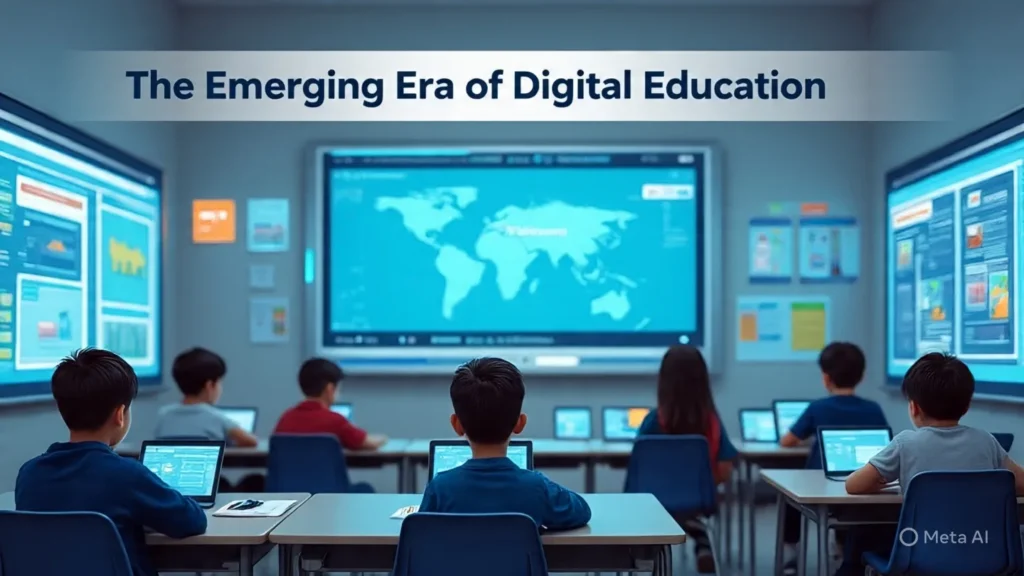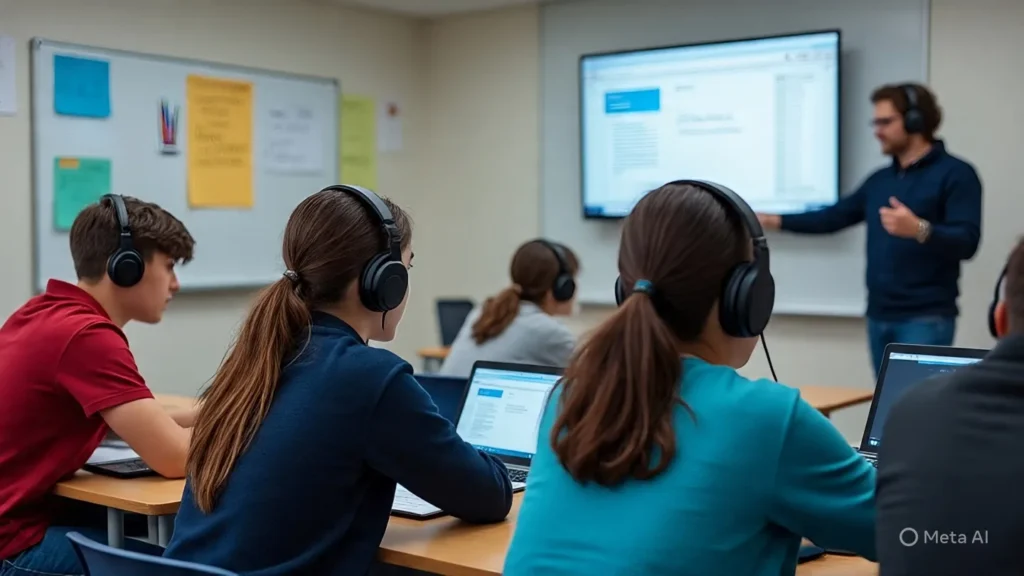1. Introduction – Digital Education Ka Yug Shuru
Aaj ham Digital Education Ka Ubharta Hua Yug me ji rahe hai . Pichhle kuch saalon mein education system mein ek bada badlav aaya hai. Pehle ke zamane mein padhai matlab tha blackboard, chalk, aur classroom mein teacher ke saath baithkar seekhna. Lekin ab technology ne is purane tareeke ko ek naye roop mein badal diya hai.
Aaj log smartphones, laptops, aur internet ke zariye ghar baithe duniya bhar ka gyan haasil kar rahe hain. Digital education ab ek naya yug shuru kar chuka hai, aur iska asar har student, teacher, aur samaj par dikh raha hai.
COVID-19 pandemic ne is transition ko aur tezi di. Jab schools aur colleges band hue, tab online padhai ek option nahi, balki zarurat ban gayi. Zoom classes, Google Classroom, aur YouTube lectures ne students ko padhai ka ek naya tareeka diya. Is blog post mein hum baat karenge ki digital education kya hai, iske fayde aur chunautiyan kya hain, aur yeh India ke future ko kaise shape kar raha hai.

2. Digital Education Kya Hai?
Digital education, yaani e-learning, ek aisa tareeka hai jisme technology ka use karke education provide ki jati hai. Ismein physical classroom ki zarurat nahi hoti; students online platforms ke zariye padh sakte hain. Yeh hai kuch examples: YouTube classes, Zoom lectures, Google Classroom, Byju’s, aur Unacademy.
Digital education ka matlab hai remote learning, jisme flexibility aur technology ka use hota hai. Chahe woh recorded video lectures ho, live classes ho, ya interactive quizzes, yeh sab digital education ka hissa hain. Isne na keval students ke liye learning ko aasan banaya hai, balki teachers ke liye bhi naye opportunities khole hain.

3. Online Padhai Ke Fayde (Advantages of Online Learning)
Online padhai ne education ko ek nayi disha di hai. Chaliye dekhte hain iske kuch bade fayde:
3.1 Flexible Timing
- Students apne time ke hisaab se padh sakte hain. Subah ho ya raat, apne schedule ke according padhai kar sakte hain.
- Recorded lectures ko pause, rewind, ya fast-forward karne ka option hota hai.
3.2 Access from Anywhere
- Ghar baithe, ya kisi bhi jagah se world-class education haasil kar sakte hain.
- Chhote shehron ya gaon mein rehne wale students bhi ab top universities ke courses access kar sakte hain.
3.3 Cost-Effective
- Traditional coaching ya college ke mukable online courses mein travel aur hostel ka kharcha nahi hota.
- Kai courses free ya low-cost mein available hote hain.
3.4 Personalized Learning
- Videos ko repeat kar sakte hain agar samajh nahi aaya.
- AI-based platforms weak areas ko identify karke customized content dete hain.
3.5 Skill-Based Learning
- Online padhai ke saath students digital skills bhi seekh rahe hain, jaise coding, digital marketing, ya data analysis.
- Yeh skills job market mein bahut demand mein hain.
4. Online Education Platforms Ki Badhati Popularity
India mein online education ka market tezi se badh raha hai. Kuch platforms jo students ke beech khaas popular hain:
4.1 Byju’s
- School students ke liye interactive aur engaging content.
- Video lessons aur quizzes ke zariye learning ko mazedar banata hai.
4.2 Vedantu
- Live classes aur one-on-one doubt-solving sessions.
- Affordable courses aur experienced teachers.
4.3 Unacademy
- Competitive exams jaise UPSC, NEET, aur JEE ke liye best.
- Top educators ke live sessions aur recorded lectures.
4.4 Government Initiatives
- SWAYAM: Free courses school se lekar higher education tak.
- DIKSHA App: Teachers aur students ke liye digital resources.
- ePathshala: NCERT books aur study material online.
Bade tech giants jaise Google aur Microsoft bhi education sector mein active hain, jaise Google Classroom aur Microsoft Teams ke through.
5. Digital Divide: Online Padhai Ki Chunautiyan
Online education ke bohot fayde hain, lekin iske saath kuch challenges bhi hain:
5.1 Internet aur Devices Ki Kami
- Rural areas mein students ke paas smartphones ya laptops nahi hote.
- Internet connectivity ki problem bhi ek bada issue hai.
5.2 Technical Issues
- Slow internet ya electricity cut hone se classes miss ho jati hain.
- Technical glitches classes ke flow ko disturb karte hain.
5.3 Lack of Interaction
- Classroom mein hoti hai woh face-to-face interaction online mein miss hoti hai.
- Group discussions aur extracurricular activities ka maza nahi milta.
5.4 Self-Discipline Ki Zarurat
- Ghar par padhne mein distractions jaise social media ya games zyada hote hain.
- Students ko khud motivate rehna padta hai.
5.5 Assessment Ka Issue
- Online exams mein cheating ka risk hota hai.
- Real learning ka pata lagana mushkil hota hai.
6. Teachers Ki Role aur Unka Transition
Digital education ke saath teachers ka role bhi badal gaya hai. Pehle teachers sirf lecture dete the, lekin ab unhe naye tools aur software seekhne padte hain, jaise Zoom, Google Classroom, ya LMS platforms.
6.1 Training Ki Zarurat
- Teachers ko online teaching ke liye training leni padti hai.
- New technology ko adopt karna aur students ko engage karna ek challenge hai.
6.2 Role Shift
- Teachers ab sirf knowledge provider nahi, balki guide aur facilitator ban gaye hain.
- Unhe students ke doubts online solve karne aur interactive content banane ki zarurat hoti hai.
7. Online vs Offline Education: Kya Behtar Hai?
Dono ke apne-apne fayde aur nuksaan hain. Chaliye compare karte hain:
7.1 Online Education
- Pros: Convenience, flexibility, aur cost-effective.
- Cons: Interaction kam, discipline ki zarurat.
7.2 Offline Education
- Pros: Discipline, real-time doubt-solving, aur social interaction.
- Cons: Fixed schedule, travel aur cost zyada.
7.3 Hybrid Model
- Future mein blended learning (online + offline) sabse behtar option hoga.
- Ismein flexibility aur interaction dono ka balance rahega.
8. Future of Digital Education in India
Digital education ka future India mein bahut bright hai. Kuch trends jo isko shape karenge:
8.1 5G aur Affordable Devices
- 5G technology se internet speed aur connectivity improve hogi.
- Affordable smartphones aur laptops rural areas mein bhi pahunchenge.
8.2 AI aur VR
- AI personalized learning experiences dega.
- Virtual Reality (VR) aur Augmented Reality (AR) se padhai immersive aur interesting banegi.
8.3 Government Support
- Digital India aur NEP 2020 jaise initiatives digital education ko boost kar rahe hain.
- Free platforms jaise SWAYAM aur DIKSHA sabke liye accessible hain.
9. Conclusion – Naye Yug Ki Nayi Shiksha
Digital education ek revolution hai jo education ko har ghar tak le ja raha hai. Yeh na keval students ke liye accessible aur flexible hai, balki unhe modern skills bhi sikhata hai. Lekin iske saath challenges jaise digital divide aur technical issues ko bhi solve karna zaroori hai. Government aur private sector ke saath milkar infrastructure ko improve karke aur awareness badhakar hum digital education ko aur behtar bana sakte hain.
Agar aap bhi is naye yug ka hissa banna chahte hain, toh aaj hi kisi trusted platform par enroll karein aur apni padhai ko nayi unchaiyon tak le jayein!


